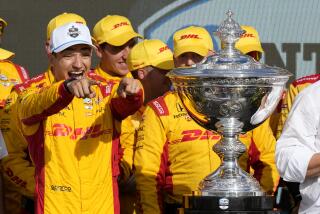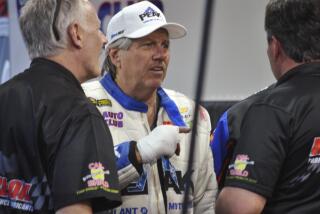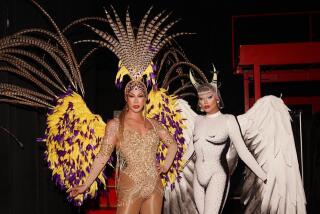On Land or Water, This Texan Is Known as Fastest Eddie
Eddie Hill is a Texan. You can tell it by the Texas-sized diamond-studded ring he wears. It’s a map of the Lone Star State. And you can tell it by the big red star on his helmet--the star of a Texas Ranger’s badge.
Eddie is a fast Texan, maybe the fastest ever.
He has driven a top fuel dragster from a standing start through a quarter-mile speed trap in 4.936 seconds, fastest in the sport’s history.
He is the only man to simultaneously hold water and land drag racing speed records--288.73 m.p.h. in his yellow Super Shops top fuel dragster last March 19 at Gainesville, Fla., and 229.00 in his propeller-driven boat, The Texan, on Sept. 5, 1982 at Chowchilla, Calif.
Although Hill has emerged this season as the fastest gun in the sport, the year has been one of emotional highs and depressive lows for the gray-bearded 52-year-old from Wichita Falls.
In March, at the National Hot Rod Assn. Gatornationals in Florida, he won his first major drag racing championship since returning to the sport after 11 years of racing boats. It was in that meet that he had the 288.73 run.
Three weeks later, he became the first to break through the seemingly unattainable 5-second barrier with a 4.990-second run during the International Hot Rod Assn.’s Texas Nationals at the Texas Motorplex near Dallas.
“This barrier is probably one of the last great barriers in drag racing,” Hill said. “You’ll probably never see anyone in the 3s.”
He followed that with a victory at the NHRA Southern Nationals in Commerce, Ga., making it three straight national victories.
The lean Texan, easy to spot with his distinctive long, gray hair and his blonde wife, Ercie, managing things on race day, seemed unbeatable--the latest claimant to the top fuel mantle held for so many years by Don Garlits and Shirley Muldowney.
Then the bottom fell out.
Hill failed to qualify for the NHRA Mid-South Nationals at Memphis, a misfortune that probably will cost him the Winston World Championship bonus of $150,000. This, even though he ran 277 m.p.h., second fastest of the meet.
“We had all the power we wanted,” Hill recalled. “Too much, in fact. We couldn’t calm it down to keep from smoking the tires. I’d stand on it, the tires would smoke, I’d let off and then stand on it again and we’d go through the traps like a winner--too late.
“The harder we tried to figure out the combination, the worse things got. I made a couple of bad lane choices that cost us, we ran some extra races to try and work things out and nothing worked.”
Hill went through a 10-race slump without winning. Only once did he even reach the final round.
Then came the NHRA Supernationals in Houston 3 weeks ago. Hill had just won an IHRA race at Bristol, Tenn., and was looking forward to running on the newly built Houston track, considered one of the world’s fastest.
The first round of qualifying on Thursday: “Pow,” his supercharger exploded just off the starting line.
“It was the first time anything like that had ever happened to us,” Hill said. “The car was running normal during the burnout, but as soon as I stepped on the throttle, all hell broke loose.”
The second round of qualifying on Friday: “Pow,” another supercharger explosion.
“After that second blower blew, I studied the computers and thought I had my finger on the problem,” he said.
The third round of qualifying on Saturday morning: “Pow,” another explosion that sounded like a load of TNT going off.
Hill was through.
“That was it. We were out of blowers and (had) no money to buy a new one.
“Three runs and we had not made a full tire revolution. The computers showed we had run less than 2 feet in 3 runs. Just nine-tenths of a second total time on the computer tape.
The team issued a statement, quoting Hill: “We got to the end of the money before we got to the end of the season.”
About the time that statement was being distributed in the press room, the problem was diagnosed by electronics expert Brian Clark of Mallory ignitions as nothing more than a poorly grounded coil.
“It still seemed hopeless,” Hill said. “We were flat out of parts in the trailer and there was less than 4 hours before the last qualifying run.”
Once the word got out, though, Hill was flooded with offers of help from other teams.
“The response was overwhelming,” he said. “Earl Whiting loaned us a blower, Jerry Gwynn (father of Darrell Gwynn, Hill’s nearest competitor for second place in the standings) opened up his trailer and told us anything in there was ours if we needed it. Gene Snow said if he could help, just let him know what he could do.
“Joe Pisano, who had a car to prepare in another class, spent an hour with us, helping us get squared away and then loaned us another part that we had to have or we couldn’t run. We found out that drag racers are really one big family.”
Hill and chief mechanic Fuzzy Carter, with the help of many hands, patched the car back together barely seconds before what would be his final attempt to qualify.
“It was an absolutely crazy scene,” Hill said. “There I was, only a short time before, ready to turn tail and head for the house, and now I was climbing in my race car.”
Hill ran a 5.03 to make the race and, in the ultimate irony, the driver he bumped from the 16-car field was Whiting, whose supercharger Hill had borrowed.
“What a gentleman,” Hill said. “I felt terrible about bumping Earl, but when I apologized to him for getting in the show with his blower, he said not to worry, that it was his fault because he hadn’t driven fast enough.
“That blower’s still in the car. We’re going to use it again this week.”
Then Hill grinned and said, “Of course, I’ve since paid him for it.”
The next day, Hill ran a 4.990 to beat Snow in the semifinals and then blew off former national champion Joe Amato in the final with the fastest run in history, 4.936.
“We won $25,000 and it just about let us break even after blowing up three blowers, cylinder heads, manifolds and fittings.
“Ercie and I had reviewed our options after the third blower exploded and we were as down as down can be. We’d spent the last of our sponsorship money to buy those three blowers and a lot of other stuff. We thought we’d overstocked the trailer and, all of a sudden, we were out of parts and no money to buy new ones.
“It was a terrible feeling. I’d worked all my life to be a professional racer and when we finally got corporate sponsorship for this season, it looked like we’d made it. We felt honor bound to help justify their backing, especially when I’d never won a race before they signed us up.
“We felt that if we failed at Houston, it would drop us to fourth in the standings and it would look like we’d completely lost the handle on racing.”
Texas has always been good to the Hills, though, and a week after winning at Houston, they were in Ennis for the IHRA Chief Nationals. Hill, the coil in his supercharger now properly grounded, clicked off 3 sub-5-second runs and defeated Gwynn in the final.
The victory, parlayed with his earlier Texas Motorplex win in April, was worth $100,000 to Hill in bonus money from IHRA and Motorplex owner Billy Meyer for winning 2 major races at the track in the same year. A similar bonus was offered in funny cars and another $100,000 was taken by Ed (Ace) McCulloch of Hemet.
“Counting prize money and all, Ed and I took away about a quarter of a million dollars from Billy that weekend,” Hill said, smiling.
Hill also was named the IHRA’s driver of the year.
Last Sunday, at Firebird International Raceway in Chandler, Ariz., Hill won his second straight NHRA event, the Fallnationals, and moved into second place behind Amato in the standings. However, he trails the 1984 champion by an almost insurmountable 1,032 points with only one event remaining, this weekend’s $937,400 Winston Finals at the Los Angeles County Fairplex.
“I love this Pomona track,” he said. “We set the record (283.91 m.p.h.) here 2 years ago. “The fans are very receptive and that’s always nice. I’d rate the track from good to excellent.
“We can’t expect to win every time, but we’ve won 4 in a row and we’re not going to quit trying.”
This is Hill’s 33rd year in racing, of one sort or another.
He made his first quarter-mile pass in 1955 on a backwoods strip at the Flying Fish Lodge in Karnack, Tex. He drove his mother’s Chevrolet in the stock class and a Model T rail with an Oldsmobile V-8 engine in the open class.
He had competed in his first race, however, when he was 11. He drove a Cushman motor scooter in the Tri-State Motor Scooter Flat Track championship races at Shreveport, La. He won.
“That trip was a low-budget affair,” he said. “My father was a veterinarian, and we hauled the scooter in his horse trailer. We couldn’t afford the $6 for a motel room so we slept in the horse trailer.”
Hill graduated from Texas A&M; in 1957 with a degree in industrial technology, but after working briefly as a sales engineer, he became a full-time race driver.
He raced dragsters with moderate successes until 1965, when he ran into the same problem he faced this year at Houston--no money.
Only that time he actually quit, turning to motorcycles. Hill opened a cycle shop that he still owns in Wichita Falls and decided to race what he sold. He tried it all, winning races in short track, hare scrambles, motocross and drag racing and the Texas state road racing championship for production bikes in 1972.
One summer day in 1974, he visited the Austin Aquafest and saw his first drag boat race. Twenty-seven days later he owned his first boat and embarked on a drag boat career that made him the No. 1 personality in the sport.
He won the first race on water he entered, in Oklahoma City, and in his third race he set national speed and elapsed-time records at Liberty, Tex.
Before he retired, after a crash at Firebird Lake in Arizona, Hill held records in all four drag boat organizations and twice won the World Series of Drag Racing.
“When I won my second World Series, I went through the timing trap at 217 m.p.h. and everything felt perfect. The rooster tail was smooth, there was no bouncing, no sponson walk and no steering problem.
“Ercie was watching from the bank and when I’d cleared the finish line and clinched the World Series, she headed for the truck. When she heard a gasp from the crowd, she thought something had happened to the other boat because mine had been such a smooth run.
“But it was me. The boat was slowing down when it suddenly lifted like an airplane, did a 270-degree rotation in the air, banked to the left and slammed me down in the water.”
The impact gave Hill a concussion, broke seven bones and laid him up for nearly a year.
“When they pulled me out of the water, my eyeballs were popped out of the sockets. Both my eyes were black and the whites were blood-red. There wasn’t a bit of white showing. I looked like something out of a Steven Spielberg scene.”
During his year’s recuperation, Hill decided to return to asphalt drag racing.
“It wasn’t only the danger, although that had a lot of do with it, but drag boat racing didn’t seem to be getting any more professional, the way that drag racing had.”
His first 6 months back on asphalt were not particularly encouraging.
“The transition was a little more difficult than I thought it would be. When I first started in drag racing, I won top eliminator with a run of 106 m.p.h. and when I got back in it they were running 250. Now we’ve run the first ET (elapsed time for a quarter mile) under 5 seconds, and top speeds are getting close to 290.
“When we raced boats, we had the best engine life of anyone. Basically, running boats and cars are similar, as far as the engines are concerned, but it took us a long time to get the fuel curve just right in the car. The boat ran with one fuel pump, while we have two on the car, each one larger than the one we had on the boat. It took awhile for us to master the difference.”
The difference in horsepower is enormous. In the boat it never was more than 2,000, Hill said. When he turned his 4.93-second run, engineers from Racing Systems Analysis, which specializes in the study of drag racing technology, estimated that the engine was putting out in the neighborhood of 4,800 horsepower.
“You can’t prove or disprove it, but in the long run it all comes down to how much fuel a car can burn, and burn efficiently,” Hill said. “That’s what it’s been all about since Day 1.
“I know one thing, when you leave the starting line, it feels like being rear-ended by an 18-wheel truck at 100 m.p.h.”
Ercie Hill is a former paralegal secretary who met Eddie at a drag boat race in High Point, N.C. She is the most visible member of the Hill team on race day.
With her long hair flying in all directions, Ercie has a high profile as she stands in front of the sleek, 282-inch dragster, lining up Eddie for the run after his tire-smoking burnout.
That’s what’s apparent.
Ercie also does all the mixing of the exotic nitro-methane fuel that propels her husband’s dragster.
“She has put every drop of fuel into my car,” Hill said. “There’s a kind of black art to fuel mixing, and she does it as well as, or better than, anyone else in the business.”
According to Ercie, the toughest part is hoisting the 60-pound fuel jugs out of the trailer and dumping them in the car.
She also keeps an information book with more than 140 entries and computer sheets for every run in an event.
“It’s so bulky we can’t even carry a whole year’s worth with us,” Ercie said. “We have to keep it in a lawyer’s briefcase.”
She is also in charge of spark plugs--preparing, setting and rechecking the 16 plugs before and after every run.
“One time she got a standing ovation from the crowd,” Hill said. “She was screwing in the spark plugs as I was being towed to the line.”
More to Read
Go beyond the scoreboard
Get the latest on L.A.'s teams in the daily Sports Report newsletter.
You may occasionally receive promotional content from the Los Angeles Times.










